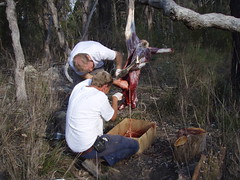As always, we are busy and made more pressed for time with a four day Christmas vacation coming quick. We could just stick around the farm and keep working, but we are getting a little worn out. Time for the beach!
There are many different projects going, at various stages of development. The following is a run down of some of what we've done within the last month.
Our Captain Mr. Freddy the fencer headed the fence project up. It took a while to complete as none of us had ever built a rabbit and roo proof fence. Is there such a thing??? A combination of home milled, courtesy of Fred, and locally milled wood was used in construction. It would have been ideal to use only home milled wood but this was not possible, as time and effort is spread out amongst several different projects on any given day. If the time had been taken to home mill the entire fence it would have taken far too long to erect, and the garden would soon become Le plat du jour for roo and rabbit alike.
In November Owen, a friend of Jesse and Freddy from California, showed up to lend a hand for a couple weeks. It made all the difference in the world to have an extra pair of hands around. An added bonus was a fresh face offering tons of encouragement and support. It takes a very special person to put up with Jesse and I and we give much thanks to Owen and his fantastic attitude. Get Crackin!!!
The garden area expanded a bit to include a gravel pad that will give access to farm vehicles. This area will be the multi use working space for washing up veggie's and any other activities involved in gardening and harvest. This was another 'wheelbarrow project' involving lots of hard work spread out over several days. The whole garden area is very large. In the coming months many hours will be dedicated to refining the system and planning for the future.
It is commonly suggested that diakon radish and mustard are both excellent cover crops to repair damaged soils and building soil structure. An added benefit is the ability of the plant flowers to attract beneficial insects into the garden. These plants have both been broadcast seeded throughout several systems on the farm site as well as being trialed in these two plots.
These two plants have worked very well under various conditions and soil types. They both exhibit great germination rates and vigorous growth giving good soil coverage. Several species of beneficial insects have been observed on and around these plants. Weather was a huge factor for us too. Nothing seems to replace that natural rain that comes down nearly daily on the farm. In fact, just today a thick fog rolled in followed shortly by rain.
In mid November 760 tree seedlings arrived at the farm and planting became priority. These trees were a free subsidy from the local land care group and all are hardy native species several of which produce very useful timber wood. Most of the trees were planted as wind breaks. This is Owen helping us prepare a windbreak composed of 33 individual swale mounds down the length of a treeless ridge. At this point in time Martina, from Italy, had just arrived which was great, as the job of planting these trees is challenging. It was really nice to have everyone planting trees and four countries being represented all learning a bit about Permaculture. We were busy with planting for a long time and still have some to do. A total of 48 swales were constructed and there are about 150 trees left over.
This is one of the main windbreaks where we planted a combination of trees and shrubs. We received Acacia melanoxylon, Grevillea robusta, Lophostemon confertus ,which are all great timber trees, with several varieties of Eucalyptus. Tagastase and Pigeon Pea have been interplanted and of course a mix of herbaceous cover crop, which is coming up nicely.
For the last month rain has become common and Jesse and I feel right at home, being from Vancouver and all. One morning the rain gauge registered 82mm over night, a real cracker!!!
The swale filled up with water that morning. The swales are working very well with no damage since the 70mm event a while back. The timing of the rain could not have been more perfect with most of the trees in the ground and a garden planted.
Will run-away climate change make drought permanent?
18 years ago





















































